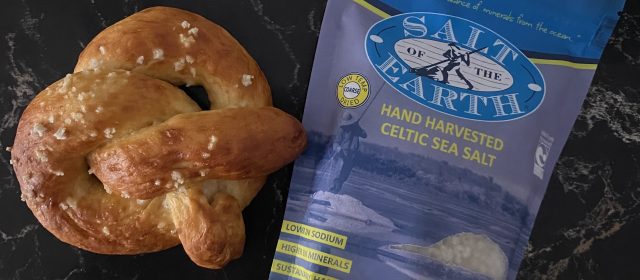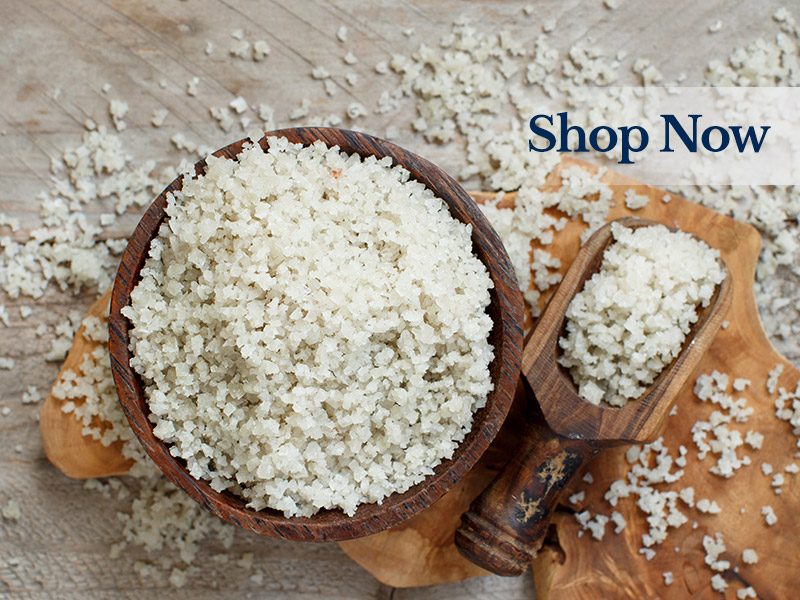Categories
Soft Pretzels with Celtic Sea Salt
These delicious soft pretzels are salty, buttery and slightly sweet. Made with Celtic Sea Salt to add a nice flavour dimension. Celtic Sea Salt has a slightly different taste profile compared to regular table salt, often described as having a more complex, briny flavor. This enhances the overall taste of the pretzel, giving it a unique twist.
RECIPE
Servings: 6
Prep Time: 30 Minutes
Cook Time: 10 Minutes
Total Time: 40 Minutes, plus 1 to 2 hours to rise
Ingredients
- 1 cup milk
- 5 tablespoons unsalted butter, divided
- 3 tablespoons light brown sugar, packed
- 2¼ teaspoons instant/rapid-rise yeast (1 package)
- 3 cups all-purpose flour, spooned into measuring cup and leveled-off
- 1 teaspoon fine Celtic Sea Salt
- ¼ cup baking soda
- ¾ teaspoon coarse Celtic Sea Salt
Directions
- Warm the milk and 2 tablespoons of butter in a small saucepan until the butter just melts; avoid boiling. (Alternatively, heat the butter and milk in the microwave for about 90 seconds.) Add the brown sugar and stir until it dissolves, then set aside.
- Combine the flour, yeast, and fine Celtic Sea Salt in a large bowl. With an electric mixer with a paddle attachment mix on low speed for about 1 minute until well combined. With the mixer on low, gradually pour in the warm milk and butter mixture. Once the dough forms a cohesive mass, switch to the dough hook. Knead on medium-low speed for about 5 minutes until the dough is smooth but still slightly tacky. (Alternatively, the dough can be mixed and kneaded by hand.)
- Shape the dough into a ball, place it in a clean, lightly greased bowl, cover with plastic wrap, and let it rise in a warm place until it doubles in size, about 1 to 2 hours.
- Preheat the oven to 230 degrees Celsius and line a large baking tray with baking paper and lightly spray it with nonstick cooking spray.
- In a 1.5L baking dish, dissolve the baking soda in 2¼ cups of warm water, then set aside. (Dipping the pretzel dough in this baking soda solution helps create a golden-brown crust.)
- Punch down the dough to deflate it, then turn it onto a clean work surface. (If sticky, dust lightly with flour as needed.) Shape the dough into a log, cut it into 6 equal pieces, and cover with a damp dishtowel to prevent drying. Roll each piece with your palms into a 60cm rope, stretching it by holding the ends and lightly slapping the middle of the rope on the counter.
- Using both hands, gently dip each rope into the soda solution, allowing excess liquid to drip off. Form each piece into a pretzel shape directly on the prepared baking sheet: form a “U” shape, cross the ends over each other in the center, twist once, and press the ends onto the base of the pretzel. Sprinkle with coarse Celtic Sea Salt and bake for 8 to 12 minutes until golden brown, watching the bottoms closely to avoid burning.
- Melt the remaining 3 tablespoons of butter and brush over the baked pretzels. Enjoy warm from the oven or reheat, using the oven or microwave.
Note: You may substitute active dry yeast for instant yeast, though the dough will take longer to rise. Dissolve the active dry yeast in the warm milk and butter mixture, let sit until frothy (about 10 minutes), and then proceed with the recipe.
Note: For a cinnamon sugar topping, skip the coarse salt. After baking, brush with butter and sprinkle with cinnamon sugar (½ cup sugar and about ¾ teaspoon cinnamon).
Make-Ahead Instructions: Once risen, the dough can be refrigerated for up to three days or frozen for a few months. Thaw frozen dough in the refrigerator before using. While still cool, shape the dough into pretzel bites and allow about 30 minutes for them to puff up slightly before dipping and baking.
Nutrition Information
Serving size: 1 pretzel
Calories: 331
Fat: 12 g
Saturated fat: 7 g
Carbohydrates: 49 g
Sugar: 9 g
Fiber: 2 g
Protein: 7 g
Sodium: 2540 mg
Cholesterol: 30 mg
Please note: While all care is taken to provide accurate nutritional information, these figures should be considered estimates only. Varying factors such as product brands used, natural fluctuations in fresh produce, and the way ingredients are processed change the effective nutritional information in any given recipe. To obtain the most accurate nutritional information in a given recipe, you should calculate the nutritional information with the actual ingredients used in your recipe, using your preferred online nutrition calculator.


